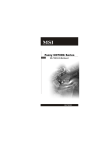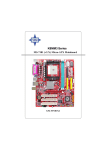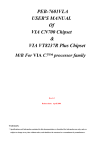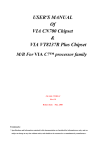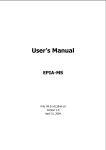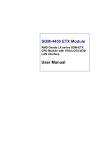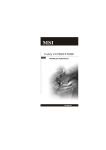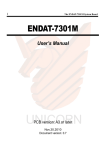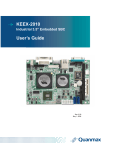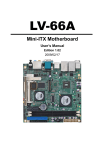Download MSI Axis 700 Instruction manual
Transcript
Axis 700 Axis 700 Lite MS-6427 (V1.X) Barebone G52-64271X1 FCC-B Radio Frequency Interference Statement This equipment has been tested and found to comply with the limits for a class B digital device, pursuant to part 15 of the FCC rules. These limits are designed to provide reasonable protection against harmful interference in a residential installation. This equipment generates, uses and can radiate radio frequency energy and, if not installed and used in accordance with the instruction manual, may cause harmful interference to radio communications. However, there is no guarantee that interference will not occur in a particular installation. If this equipment does cause harmful interference to radio or television reception, which can be determined by turning the equipment off and on, the user is encouraged to try to correct the interference by one or more of the measures listed below. =Reorient or relocate the receiving antenna. =Increase the separation between the equipment and receiver. =Connec the equipment into an outlet on a circuit different from that to which the receiver is connected. =Consult the dealer or an experienced radio/television technician for help. Notice 1 The changes or modifications not expressly approved by the party responsible for compliance could void the user’s authority to operate the equipment. Notice 2 Shielded interface cables and A.C. power cord, if any, must be used in order to comply with the emission limits. VOIR LA NOTICE D’INSTALLATION AVANT DE RACCORDER AU RESEAU. Micro-Star International Axis 700 This device complies with Part 15 of the FCC Rules. Operation is subject to the following two conditions: (1) this device may not cause harmful interference, and (2) this device must accept any interference received, including interfer ence that may cause undesired operation. ii Trademark All trademarks are the properties of their respective owners. Intel® and Pentium® are registered trademarks of Intel Corporation. PS/2 and OS ® /2 are registered trademarks of International Business Machines Corporation. W indows ® 95/98/2000/NT/XP are registered trademarks of Microsoft Corporation. Netware® is a registered trademark of Novell, Inc. Award® is a registered trademark of Phoenix Technologies Ltd. AMI® is a registered trademark of American Megatrends Inc. U.S. Patent Numbers 4,631,603; 4,819,098; 4,907,093; 5,315,448; and 6,516,132. This product incorporates copyright protection technology that is protected by U.S. patents and other intellectual property rights. Use of this copyright protection technology must be authorized by Macrovision, and is intended for home and other limited viewing uses only unless otherwise authorized by Macrovision. Reverse engineering or disassembly is prohibited. Revision History Revision Revision History Date v1.0 First release August 2006 Copyright Notice T he material in this document is the intellec tual property of M ICRO-STAR INTERNATIONAL. W e take every care in the preparation of this document, but no guarantee is given as to the correctness of its contents. Our products are under continual improvement and we reserve the right to make changes without notice. iii Safety Instructions 1. Always read the safety instructions carefully. 2. Keep this User’s Manual for future reference. 3. Keep this equipment away from humidity. 4. Lay this equipment on a reliable flat surface before setting it up. 5. The openings on the enclosure are for air convection hence protects the equipment from overheating. DO NOT COVER THE OPENINGS. 6. Check power supply rating: 100-240V~, 3-1.5A, 60-50Hz. 7. Place the power cord such a way that people can not step on it. Do not place anything over the power cord. 8. Always Unplug the Power Cord before inserting any add-on card or module. 9. All cautions and warnings on the equipment should be noted. 10. Never pour any liquid into the opening that could damage or cause electrical shock. 11. If any of the following situations arises, get the equipment checked by service personnel: - The power cord or plug is damaged. - Liquid has penetrated into the equipment. - The equipment has been exposed to moisture. - The equipment does not work well or you can not get it work according to User’s Manual. - The equipment has dropped and damaged. - The equipment has obvious sign of breakage. 12. DO NOT LEAVE THIS EQUIPMENT IN AN ENVIRONMENT UNCONDITIONED, STORAGE TEMPERATURE ABOVE 400 C (1020F), IT MAY DAMAGE THE EQUIPMENT. CAUT ION: Danger of explos ion if battery is inc orrec tly replac ed. Replace only with the same or equivalent type recommended by the manufacturer. iv Warning: 1. For every changes in powercordˇ¦s usage, please use an approved power cord with condition greater or equal to H05VV-F,3G , 0.75mm2. 2. Internal part is hazardous moving parts, please keep fingers and other body parts away. 3. For pluggable equipment, the socket-outlet shall be installed near the equipment and shall be easily accessible. 4. Do not disable the protective earth pin from the plug, the equipment must be connected to an earthed mains socket-outlet. v WEEE Statement vi vii viii CONTENTS Chapter 1. Getting Started...................................................................................1-1 Mainboard Specifications..............................................................................1-2 System Configuration....................................................................................1-4 Chapter 2. Hardware Setup..................................................................................2-1 Mainboard Layout.........................................................................................2-2 Memory..........................................................................................................2-3 Introduction to DDRII SDRAM...............................................................2-3 Installing DDRII Modules........................................................................2-3 Power Supply................................................................................................2-4 ATX 20-Pin Power Connector: ATXPWR..............................................2-4 Front Panel....................................................................................................2-5 Audio Ports..........................................................................................2-5 USB Ports.............................................................................................2-5 Rear Panel.....................................................................................................2-6 Connectors....................................................................................................2-8 ATA 133 IDE Connector: IDE1...............................................................2-8 Serial ATA Connectors: SATA1/SATA2...............................................2-9 Fan Power Connector: SYSFAN1......................................................2-10 CD-In Connector: CD_IN......................................................................2-10 Front Panel Audio Connector: JAUD..................................................2-10 Front Panel Connectors: JFP1/JFP2....................................................2-11 Chassis Intrusion Switch Connector: JCI1.........................................2-12 Front USB Connectors: J3/J4/J5.........................................................2-12 Wake On LAN Connector: J9.............................................................2-13 Jumper...........................................................................................................2-14 Clear CMOS Jumper: JBAT1.............................................................2-14 Slot................................................................................................................2-15 PCI Slot.................................................................................................2-15 Chapter 3. BIOS Setup.............................................................................................3-1 Entering Setup...........................................................................................3-2 Control Keys........................................................................................3-3 Getting Help..........................................................................................3-3 General Help <F1>...............................................................................3-3 The Main Menu............................................................................................3-4 Standard CMOS Features...........................................................................3-6 Advanced BIOS Features...........................................................................3-9 Advanced Chipset Features.......................................................................3-12 Integrated Peripherals.................................................................................3-15 ix Power Management Setup.........................................................................3-19 PNP/PCI Configurations................................................................................3-23 H/W Monitor.................................................................................................3-25 Cell Menu.....................................................................................................3-27 Load Optimized Defaults.............................................................................3-28 BIOS Setting Password..............................................................................3-29 Chapter 4. System Assembly...............................................................................4-1 Overview.....................................................................................................4-2 Installation Tools....................................................................................4-2 Sc rews.................................................................................................4-2 Checking the Items................................................................................4-3 Installation Procedures.................................................................................4-4 Removing Top Cover...........................................................................4-4 Removing Optical Disk Drive................................................................4-5 Removing Card Reader.......................................................................4-6 Removing Riser Card...........................................................................4-7 Removing Hard Disk Drive...................................................................4-7 Installing Hard Disk Drive......................................................................4-8 Installing Riser Card..............................................................................4-8 Installing Card Reader.........................................................................4-9 Installing Optical Disk Drive..................................................................4-9 Installing Memory Modules...................................................................4-10 Restoring Chassis Cover.....................................................................4-12 Installing Footstand...............................................................................4-13 Appendix A. VIA VT1618 Audio.............................................................................A-1 Installing the Audio Driver............................................................................A-2 Installation for Windows 98SE/ME/2000/XP........................................A-2 Software Configuration...............................................................................A-4 Speaker................................................................................................A-4 Mixer....................................................................................................A-5 Speaker Test.......................................................................................A-6 Information...........................................................................................A-6 Hardware Setup.........................................................................................A-7 Connecting the Speakers...................................................................A-7 2-Channel Mode for Stereo-Speaker Output.......................................A-7 4-Channel Mode for 4-Speaker Output...............................................A-8 6-Channel Mode for 4-Speaker Output...............................................A-9 x Chapter 1 Getting Started Congratulations for purchasing Axis 700 (MS-6427) barebone. Axis 700 barebone is your best Slim PC choice. W ith the fantastic appearance and ultra-small form factor, it can easily be set anywhere. The feature packed platform also gives you an exciting PC experience. M S-6427 Barebone Mainboard Specifications Processor Support - VIA ® C7 1GHz / 21x21mm nano BGA2 package TDP max 1.2GHz @12W Supports VRM mobile (down to 0.7V) Thermal design margin up to 100。 c Tcase 3D instructions SSE / SSE2 / SSE3 Security Features RGN / AES / SHA-1 Supported FSB - 400 / 533 MHz Chipset - North Bridge: VIA ® CN700 chipset - South Bridge: VIA ® VT8237R+ chipset M emory Support - Supports DDRII 400 / 533 SDRAM (2GB Max) - 1 DDRII DIMM (240pin / 1.8V) LAN - Supports PCI LAN 10/100 Fast Ethernet by VIA ® VT6103L Audio - Chip integrated by VIA ® VT1618 - Flexible 5.1-channel audio with jack sensing - Compliant with AC97 2.3 spec IDE - One IDE port by VT8237R+ - Supports Ultra DMA 66/100/133 mode - Supports PIO, Bus Master operation mode SATA - Supports two SATA ports by VT8237R+ - Supports storage and data transfers at up to 150MB/s RAID - SATA1-2 supports RAID 0/ 1 or JBOD mode by VT8237R+ 1-2 Getting Started Connectors Back Panel - 1 PS/2 mouse port - 1 PS/2 keyboard port - 2 serial ports (COMA and COMB) - 2 USB 2.0 ports - 1 LAN jack - 3 flexible audio jacks - 1 S-Video port (for standard only) - 1 DVI port (for standard only) - 1 VGA oort On-Board Pinheaders - 3 USB 2.0 pinheaders - 1 audio pinheader Slots - 1 PCI slot - Supports 3.3V/ 5V PCI bus Interface Form Factor - Mini-ITX (17 cm X 17 cm) M ounting - 4 mounting holes 1-3 M S-6427 Barebone System Configuration Front View 1. Mic-In (pink) 2. Headphone-Out (green) 3. USB 2.0 ports x 2 4. Power Button 5. HDD LED 1-4 6. 7. 8. 9. Optical Drive Eject/ Close Button Card Reader Drive (optional) Power LED Optical Drive (optional) Getting Started Rear View (Standard Version) 1. 2. 3. 4. 5. 6. 7. PS/2 Keyboard (purple) PS/2 M ouse (green) DVI Port (for standard only) VGA Port (D-Sub15) S-Video (for standard only) USB 2.0 Ports Serial Ports 8. Mic-In (pink) 9. Line-Out (green) 10. Line-In (blue) 11. Power Jack 12. Ventilation Hole 13. LAN Jacks (RJ45) 14. Expansion Slots 1-5 M S-6427 Barebone Rear View (Lite Version) 1. 2. 3. 4. 5. 6. 1-6 PS/2 Keyboard (purple) PS/2 M ouse (green) VGA Port (D-Sub15) USB 2.0 Ports Serial Ports Mic-In (pink) 7. Line-Out (green) 8. Line-In (blue) 9. Power Jack 10. Ventilation Hole 11. LAN Jacks (RJ45) 12. Expansion Slots Getting Started Chassis Design - Dimension: 363mm (D) x 300mm (W) x 72mm (H) - Minimized screw structure - Detachable bay housing - Multiple ventilation holes Back Side Bottom 1. System Ventilation Hole 3. CPU Fan Ventilation Hole 2. Power Supply Ventilation Hole 4. System Ventilation Hole 1-7 M S-6427 Barebone sharp System Picture Ventilation Hole Ventilation Po w e r Hole Supply System Po w e r Fan Supply Fan Ventilation Hole Front Panel 1-8 Getting Started System Air Flow Direction Ventilation Hole Ventilation Hole Po w e r Supply Po w e r Supply Fan Ventilation Hole Front Panel After the installation is completed, please keep other objects away from the ventilation hole at least 2.5cm and above. Do not block the ventilation hole. 1-9 Chapter 2 Hardware Setup This chapter provides you with the information about hardware s etup procedures . W hile doing the installation, be careful in holding the components and follow the installation procedures. For some components, if you install in the wrong orientation, the components will not work properly. Use a grounded wrist strap before handling computer components. Static electricity may damage the components. ONLY FOR SERVICE PERSONEL Always unplug the power cord before inserting any add-on card or module. M S-6427 Barebone Mainboard Layout Top : mouse Bottom:KB ATXPWR VIA C7 SYSFAN1 Top : VGA Port Bottom: DIV Port (for standard only) S-Video Out (for standard only) VIA CN700 DIMM1 VIA VT1622A Top: LAN Jack Bottom: USB ports VIA VT6103L J5 Top : COMA Bottom: COMB JCI1 J3 J4 T:MIC-In M:Line- In B:SS Out VIA VT8237R Plus IDE1 VIA VT1632A JBAT1 SATA1 SATA2 BIOS JAUD CD_IN VIA VT1618 BATT + J9 JFP2 PCI 1 MS-7199 (V1.X) Mini-ITX Mainboard 2-2 JFP1 Hardware Setup Memory The mainboard provides one slot for 240-pins non-ECC DDRII DIMM, which supports the memory size up to 2GB. For more information on compatible components, please visit http://www.msi.com.tw/program/products/slim_pc/slm/ pro_slm_cpu_support.php DDRII 240-pins, 1.8V 56 x 2 = 112-pins 64 x 2 = 128-pins Installing DDRII Modules 1. The DIMM memory module has only one notch on the center and will only fit in the right orientation. 2. Insert the DIMM memory module vertically into the DIMM slot. Then push it in until the golden finger on the memory module is deeply inserted in the socket. 3. The plastic clip at each side of the DIMM slot will automatically close. Important You can barely see the golden finger if the module is properly inserted in the socket. Volt Notch 2-3 M S-6427 Barebone Power Supply The mainboard supports ATX power supply for the power system. Before inserting the power supply connector, always make sure that all components are installed properly to ensure that no damage will be caused. ATX 20-Pin Power Connector: ATXPWR This connector allows you to connect to an power supply. To connect to the power supply, make sure the plug of the power supply is inserted in the proper orientation and the pins are aligned. Then push down the power supply firmly into the connector. Pin Definition PIN 1 2 3 20 10 11 ATXPWR 1 4 5 6 7 8 9 10 SIGNAL PIN PINSIGNAL 3.3V 3.3V 11 12 3.3V -12V GND 5V 13 14 GND PS_ON GND 5V 15 16 GND GND GND PW_OK 17 18 GND -5V 5V_SB 19 20 5V 5V 12V Important 1. Make sure that the connector is connected to proper ATX power supplies to ensure stable operation of the mainboard. 2. Power supply of 130 watts (and above) is highly recommended for system stability. 2-4 Hardware Setup Front Panel The Front Panel provides the following connectors: Mic-In Headphone-Out USB Ports (green) (pink) Audio Ports These audio ports allow you to connect front audio devices. Mic-In (pink) Headphone-Out (green) USB Ports The mainboard provides a UHCI (Universal Host Controller Interface) Universal Serial Bus root for attaching USB devices such as keyboard, mouse or other USB-compatible devices. You can plug the USB devices directly into these connectors. USB Ports 2-5 M S-6427 Barebone Rear Panel The Rear Panel provides the following connectors: Mouse (green) VGA S-Video (for standard only) LAN Line-In Line-Out Keyboard (purple) DVI (for standard only) USB Ports Serial Ports MIC-In M ouse/Keyboard Connector The standard PS/2® mouse/keyboard DIN connector is for a PS/2 ® mouse/ keyboard. VGA Connector The DB15-pin female connector is provided for VGA monitors. DVI Connector (for standard only) The DVI (Digital Visual Interface) connector allows you to connect an LCD monitor. It provides a high-speed digital interconnection between the computer and its display device. To connect a LCD monitor, simply plug your monitor cable into the DVI connector, and make sure that the other end of the cable is properly connected to your monitor (refer to your monitor manual for more information). S-Video Connector (for standard only) The S-Video connector allows users to connect display devices for component video input/output. S-Video (Super-Video, sometimes referred to as Y/C Video, or component video) is a video signal transmission in which the luminance signal and the chrominance signal are transmitted separately to achieve superior picture clarity. The luminance signal (Y) carries brightness information, which defines the black and white portion, and the chrominance signal (C) carries color information, which defines hue and saturation. An S-Video connection brings better video quality than a composite/RCA connection. 2-6 Hardware Setup LAN (RJ-45) Jack The standard RJ-45 jack is for connection to single Local Area Network (LAN). You can connect a network cable to it. LAN (Optional) Activity Indicator Link Indicator PIN SIGNAL DESCRIPTION 1 TDP Transmit Differential Pair 2 TDN Transmit Differential Pair 3 RDP Receive Differential Pair 4 NC Not Used 5 NC Not Used 6 RDN Receive Differential Pair 7 NC Not Used 8 NC Not Used USB Port Connectors The OHCI (Open Host Controller Interface) USB (Universal Serial Bus) root is for attaching USB devices such as keyboard, mouse, or other USB-compatible devices. Serial Port Connectors The mainboard offers two 9-pins male DIN connectors as serial ports. The ports are 16550A high speed communication ports that send/receive 16 bytes FIFOs. You can attach a serial mouse or other serial devices directly to the connectors. Audio Port Connectors These audio connectors are used for audio devices. You can differentiate the color of the audio jacks for different audio sound effects. Blue audio jack: Line-In in 5.1 channel mode, is used for external CD player, tapeplayer or other audio devices. Green audio jack: Line-Out, is a connector for speakers or headphones. Pink audio jack: Mic-In, is a connector for microphones. 2-7 M S-6427 Barebone Connectors . ATA133 IDE Connector: IDE1 The mainboard has a 32-bit Enhanced PCI IDE and Ultra DMA 66/100/133 controller that provides PIO mode 0~4, Bus Master, and Ultra DMA 66/100/133 function. You can connect hard disk drives, CD-ROM and other IDE devices. The Ultra ATA133 interface boosts data transfer rates between the computer and the hard drive up to 133 megabytes (MB) per second. The new interface is one-third faster than earlier record-breaking Ultra ATA/100 technology and is backwards compatible with the existing Ultra ATA interface. IDE (Primary IDE Connector) The first hard drive should always be connected to IDE1. IDE1 can connect a Master and a Slave drive. You must configure second hard drive to Slave mode by setting the jumper accordingly. IDE1 Important If you install two hard disks on cable, you must configure the second drive to Slave mode by setting its jumper. Refer to the hard disk documentation supplied by hard disk vendors for jumper setting instructions. 2-8 Hardware Setup Serial ATA Connectors: SATA1/SATA2 SATA1/SATA2 are high-speed Serial ATA interface ports. Each supports 1st generation serial ATA data rates of 150MB/s and is fully compliant with Serial ATA 1.0 specifications. Each Serial ATA connector can connect to 1 hard disk device. Pin Definition 1 1 7 7 PIN SIGNAL PIN SIGNAL 1 3 GND RXP 2 4 RXN GND 5 7 TXN GND 6 TXP SATA1/SATA2 Serial ATA cable Take off the Dust Cover and connect to the Hard Disk Devices Connect to SATA1/2 Important Please do not fold the Serial ATA cable into 90-degree angle. Otherwise, data loss may occur during transmission. 2-9 M S-6427 Barebone Fan Power Connectors: SYSFAN1 The Fan Power Connectors support system cooling fan with +12V. It supports 3-pins head connector. When connecting the wire to the connectors, always take note that the red wire is the positive and should be connected to the +12V, the black wire is Ground and should be connected to GND. If the mainboard has a System Hardware Monitor chipset on-board, you must use a specially designed fan with speed sensor to take the advantage of the CPU fan control. +12V SENSOR GND SYSFAN1 CD-In Connector: CD_IN This connector is provided for CD-ROM audio. R GND L CD_IN Front Panel Audio Connector: JAUD The JAUD front panel audio connector allows you to connect to the front panel audio and is compliant with Intel® Front Panel I/O Connectivity Design Guide. Pin Definition PIN 10 9 2 1 JAUD 2-10 SIGNAL DESCRIPTION 1 2 AUD_MIC AUD_GND Front panel microphone input signal Ground used by analog audio circuits 3 4 AUD_MIC_BIAS AUD_VCC Microphone power Filtered +5V used by analog audio circuits 5 6 AUD_FPOUT_R AUD_RET_R Right channel audio signal to front panel Right channel audio signal return from front panel 7 8 HP_ON KEY N/C No pin 9 10 AUD_FPOUT_L AUD_RET_L Left channel audio signal to front panel Left channel audio signal return from front panel Hardware Setup Important If you don’t want to connect to the front audio header, pins 5 & 6, 9 & 10 have to be jumpered in order to have signal output directed to the rear audio ports. Otherwise, the Line-Out connector on the back panel will not function. 10 9 6 5 Front Panel Connector: JFP1/JFP2 The mainboard provides two front panel connectors for electrical connection to the front panel switches and LEDs. JFP1 is compliant with Intel® Front Panel I/O Connectivity Design Guide. Pin Definition PIN 1 2 3 DESCRIPTION HD_LED_P Hard disk LED pull-up FP PWR/SLP MSG LED pull-up HD_LED_N Hard disk active LED 4 5 FP PWR/SLP MSG LED pull-up RST_SW_N Reset Switch low reference pull-down to GND 6 7 PWR_SW_P Power Switch high reference pull-up RST_SW_P Reset Switch high reference pull-up JFP1 8 9 PWR_SW_N Power Switch low reference pull-down to GND RSVD_DNU Reserved. Do not use. Speaker + + - PIN 1 Reset HEE Switch LED 9 10 1 2 Power Power Switch LED SIGNAL Pin Definition 2 1 8 7 Power LED 3 5 7 SIGNAL GND SLED PLED N/C PIN 2 SIGNAL SPK- 4 6 BUZ+ BUZ- 8 SPK+ JFP2 2-11 M S-6427 Barebone Chassis Intrusion Switch Connector: JCI1 This connector is connected to a 2-pin chassis switch. If the chassis is opened, the switch will be short. The system will record this status and show a warning message on the screen. To clear the warning, you must enter the BIOS utility and clear the record. 1 2 CINTRU GND JCI1 Front USB Connectors: J3/J4/J5 The mainboard provides three standard USB 2.0 pinheaders. USB 2.0 technology increases data transfer rate up to a maximum throughput of 480Mbps, which is 40 times faster than USB 1.1, and is ideal for connecting high-speed USB interface peripherals such as USB HDD, digital cameras, MP3 players, printers, modems and the like. Pin Definition 9 10 1 2 J3/J4/J5 2-12 PIN SIGNAL PIN 1 VCC 2 SIGNAL VCC 3 USB0- 4 USB1- 5 USB0+ 6 USB1+ 7 GND 8 GND 9 Key (no pin) 10 USBOC Hardware Setup USB 2.0 Bracket (Optional) Connect to J3/J4/J5 Important Note that the pins of VCC and GND must be connected correctly to avoid possible damage. Wake On LAN Connector: J9 This connector allows you to connect to a LAN card with W ake On LAN function. You can wake up the computer via remote control through a local area network. MP_WAKEUP 3 GND 5VSB 1 J9 2-13 M S-6427 Barebone Jumper The motherboard provides the following jumpers for you to set the computer’s function. This section will explain how to change your motherboard’s function through the use of jumpers. Clear CMOS Jumper: JBT1 There is a CMOS RAM onboard that has a power supply from external battery to keep the system configuration data. W ith the CMOS RAM, the system can automatically boot OS every time it is turned on. If you want to clear the system configuration, use the JBAT1 (Clear CMOS Jumper ) to clear data. Follow the instructions below to clear the data: 1 1 1 3 3 3 JBAT1 Keep Data Clear Data Important You can clear CMOS by shorting 2-3 pin while the system is off. Then return to 1-2 pin position. Avoid clearing the CMOS while the system is on; it will damage the mainboard. 2-14 Hardware Setup Slot PCI (Peripheral Component Interconnect) Slot The PCI slot supports LAN cards, SCSI cards, USB cards, and other addon cards that comply with PCI specifications. At 32 bits and 33 MHz, it yields a throughput rate of 133 MBps. PCI Slot Riser Card 2-15 BIOS Setup Chapter 3 BIOS Setup This chapter provides the information on the BIOS Setup program and allows you to configure the system for optimum use. You may need to run the Setup program when: An error message appears on the screen during the system booting up, and requests you to run SETUP. You want to change the default settings for customized features. 3-1 M S-6427 Barebone Entering Setup Power on the computer and the system will start POST (Power On Self Test) process. W hen the message below appears on the screen, press <DEL> key to enter Setup. Press DEL to enter SETUP If the message disappears before you respond and you still wish to enter Setup, restart the system by turning it OFF and On or pressing the RESET button. You may also restart the system by simultaneously pressing <Ctrl>, <Alt>, and <Delete> keys. Important 1. The items under each BIOS category described in this c hapter are under c ontinuous update for better s ys tem performance. Therefore, the description may be slightly different from the latest BIOS and should be held for reference only. 2. Upon boot-up, the 1st line appearing after the memory count Important is the BIOS version. It is usually in the format: W7265IMS V1.0 060715 where: 1st digit refers to BIOS maker as A= AMI, W= AWARD, and P= PHOENIX. 2nd - 5th digit refers to the model number. 6th digit refers to the chipset as I= Intel, N= nVidia, and V= VIA. 7th - 8th digit refers to the customer as MS= all standard customers. V1.0 refers to the BIOS version. 060715 refers to the date this BIOS was released. 3-2 BIOS Setup Control Keys <↑> Move to the previous item <↓> Move to the next item <←> Move to the item in the left hand <→> Move to the item in the right hand <Enter> Select the item <Esc> Jumps to the Exit menu or returns to the main menu from a submenu <+/PU> Increase the numeric value or make changes <-/PD> Decrease the numeric value or make changes <F1> General Help <F5> Previous Values <F7> Optimized Defaults <F10> Save & Exit Setup Getting Help After entering the Setup menu, the first menu you will see is the Main Menu. Main M enu The main menu lists the setup functions you can make changes to. You can use the arrow keys (↑↓) to select the item. The on-line description of the highlighted setup function is displayed at the bottom of the screen. Sub-M enu If you find a right pointer symbol (as shown in the right view) appears to the left of certain fields that means a submenu can be launched from this field. A sub-menu contains additional options for a field parameter. You can use arrow keys ( ↑↓ ) to highlight the field and press <Enter> to call up the sub-menu. Then you can use the control keys to enter values and move from field to field within a sub-menu. If you want to return to the main menu, just press the <Esc >. General Help <F1> The BIOS setup program provides a General Help screen. You can call up this screen from any menu by simply pressing <F1>. The Help screen lists the appropriate keys to use and the possible selections for the highlighted item. Press <Esc> to exit the Help screen. 3-3 M S-6427 Barebone The Main Menu Standard CM OS Features Use this menu for basic system configurations, such as time, date etc. Advanced BIOS Features Use this menu to setup the items of the special enhanced features. Advanced Chipset Features Use this menu to change the values in the chipset registers and optimize your system’s performance. Integrated Peripherals Use this menu to specify your settings for integrated peripherals. Power M anagement Setup Use this menu to specify your settings for power management. PnP/PCI Configurations This entry appears if your system supports PnP/PCI. H/W M onitor This entry shows your PC health status. Cell M enu Use this menu to specify your settings for CPU/AGP frequency/voltage control and overclocking. 3-4 BIOS Setup Load Optimized Defaults Use this menu to load the default values set by the mainboard manufacturer specifically for optimal performance of the mainboard. BIOS Setting Password Use this menu to set the password for BIOS. Save & Exit Setup Save changes to CMOS and exit setup. Exit Without Saving Abandon all changes and exit setup. 3-5 M S-6427 Barebone Standard CMOS Features Date (mm:dd:yy) This allows you to set the system to the date that you want (usually the current date). The format is <day> <month> <date> <year>. [Day] Day of the week, from Sun to Sat, determined by BIOS. Read only. [M onth] The month from Jan. through Dec. [Date] The date from 1 to 31 can be keyed by numeric function keys. [Year] The year can be adjusted by users. Time (hh:mm:ss) This allows you to set the system time that you want (usually the current time). The time format is <hour> <minute> <second>. 3-6 BIOS Setup IDE Channel 0 Master/Slave Press <+> or <-> to select the hard disk drive type. The specification of hard disk drive will show up on the right hand according to your selection. Press <Enter> for the sub-menu of each item: LBA/Large M ode This item allows you to enable or disable the LBA (Logical Block Address, the logical block size in hard disk) mode. DM A M ode This item allows you to enable or disable the DMA (Direct Memory Access) mode. 3-7 M S-6427 Barebone System Information Press <Enter> and the following sub-menu appears: Total M emory This item shows the memory size of your system. You cannot change any values in the Total Memory fields (read only). BIOS Version This item shows the BIOS version of your system (read only). CPU ID/uCode IO/Frequency The three items show the CPU related information of your system (read only). 3-8 BIOS Setup Advanced BIOS Features Quick Booting Setting the item to [Enabled] allows the system to boot within 5 seconds since it will skip some check items. CPU Feature Press <Enter> for the sub-menu of each item: Thermal M anagement This setting specifies the thermal technologies implemented in the Pentium M processor. TM2 Bus Ratio / TM2 Bus VID These settings specify the multiplier and VID values used by the processor in TM2 (Thermal Monitor 2) mode. 3-9 M S-6427 Barebone CPU L3 Cache Level 3 cache is the extra cache built into motherboards between the microprocessor and the main memory. Located away from the CPU, the L3 cache is slower than the L1 & L2 caches. This setting allows you to turn on or off the L3 cac he. Boot to OS/2 This allows you to run the OS/2 operating system with DRAM larger than 64MB. When you choose [No], you cannot run the OS/2® operating system with DRAM larger than 64MB. But it is possible if you choose [OS2]. Full Screen LOGO Show This item enables you to show the company logo on the bootup screen. Settings are: [Enabled] Shows a still image (logo) on the full screen at boot. [Disabled] Shows the POST messages at boot. IOAPIC Function This field is used to enable or disable the APIC (Advanced Programmable Interrupt Controller). Due to compliance with PC2001 design guide, the system is able to run in APIC mode. Enabling APIC mode will expand available IRQ resources for the system. MPS Table Version This field allows you to select which MPS (Multi-Processor Specification) version to be used for the operating system. You need to select the MPS version supported by your operating system. To find out which version to use, consult the vendor of your operating system. Boot Sequence The original IBM PCs loaded the DOS operating system from drive A (floppy disk), so IBM PC-compatible systems are designed to search for an operating system first on drive A, and then on drive C (hard disk). However, modern computers usually load the operating system from the hard drive, and may even load it from a CD-ROM drive. 3-10 BIOS Setup 1st Boot Device/2nd Boot Device/3rd Boot Device These items allow you to set the sequence of boot devices where BIOS attempts to load the disk operating system. Boot Other Device Setting the option to [Enabled] allows the system to try to boot from other device if the system fails to boot from the 1st/2nd/3rd boot device. Hard Disk Boot Priority Press [Enter] to enter a sub menu which shows every current hard drive installed. Use [PageUp] or [PageDown] key to select the first boot hard disk. 3-11 M S-6427 Barebone Advanced Chipset Features DRAM Clock/Drive Control Press <Enter> and the following sub-menu appears: DRAM Clock Use this field to configure the clock frequency of the installed DRAM. Important Be careful with the three hooks on the Front Panel. Remember to remove them gently with hands or the damages can be made easily. 3-12 BIOS Setup DRAM Timing The value in this field depends on performance parameters of the installed memory chips (DRAM). Do not change the value from the factory setting unless you install new memory that has a different performance rating than the original DRAMs. Read to Precharge (Trtp) Time interval between a read and a precharge command. Write to Read CM D (Twtr) Minimum time interval between the end of write data burst and the start of a column-read command. It allows I/O gating to overdrive sense amplifiers before read command starts. Write Recovery Time (Twr) Minimum time interval between end of write data burst and the start of a precharge command. Allows sense amplifiers to restore data to cells. DRAM Command Rate This setting controls the DRAM command rate. Select [1T Command] allows DRAM singlal controller to run at 1T (T=clock cycles) rate. Select [2T Command] makes DRAM siganl controller run at 2T rate. [1T] is faster than [2T]. AGP & P2P Bridge Control Press <Enter> and the following sub-menu appears: 3-13 M S-6427 Barebone CPU & PCI Bus Control Press <Enter> and the following sub-menu appears: PCI Master 0 WS Write W hen [Enabled], writes to the PCI bus are executed with zero wait states. PCI Delay Transaction The chipset has an embedded 32-bit posted write buffer to support delay transactions cycles. Select [Enabled] to support compliance with PCI specification version 2.1. VLink mode selection This item lets you choose the speed mode between the North Bridge & South Bridge. VLink 8X Support This item enables or disables the 8X VLink Data Rate. DRDY_Timing This item allows you to select the DRDY Timing from Slowest, Default and Optimize. 3-14 BIOS Setup Integrated Peripherals VIA OnChip PCI Device Press <Enter> and the following sub-menu appears: USB Controller Select [Enabled] if your system contains a Universal Serial Bus (USB) controller and you have USB peripherals. OnChip EHCI Controller This setting disables/enables the OnChip EHCI controller. The Enhanced Host Controller Interface (EHCI) specification describes the register-level interface for a Host Controller for the Universal Serial Bus (USB) Revision 2.0. 3-15 M S-6427 Barebone Onboard LAN Controller This setting controls the onboard LAN controller. Onboard LAN Option ROM The item enables or disables the initialization of the onboard LAN Boot ROMs during bootup. Selecting [Disabled] will speed up the boot process. Setting options: [Enabled], [Disabled]. USB Device Legacy Support Set to [Enabled] if you need to use any USB 1.1/2.0 device in the operating system that does not support or have any USB 1.1/2.0 driver installed, such as DOS and SCO Unix. Set to [Disabled] only if you want to use any USB device other than the USB mouse. AC97 Controller [Auto] allows the mainboard to detect whether an audio device is used. If an audio device is detected, the onboard AC97 (Audio Codec’97) controller will be enabled; if not, it is disabled. Disable the controller if you want to use other controller cards to connect an audio device. 3-16 BIOS Setup IDE Devices Configuration Press <Enter> and the following sub-menu appears: OnChip SATA A This setting is used to specify the SATA controller. The settings are: [Disabled] Disable the SATA controller. [Enabled] Enable the SATA controller. SATA Mode This setting is used to select the SATA mode. The setting are: [IDE] Set SATA HDD as IDE mode [RAID] RAID enabled PCI IDE BusMaster Set this option to [Enabled] to specify that the IDE controller on the PCI local bus has bus mastering capability. OnChip IDE Channel0 The integrated peripheral controller contains an IDE interface with support for two IDE channels. Choose [Enabled] to activate each channel separately. 3-17 M S-6427 Barebone IDE Prefetch Mode The onboard IDE drive interfaces support IDE prefetching, for faster drive accesses. When you install a primary and/or secondary add-in IDE interface, set this option to Disabled if the interface does not support prefetching IO Devices Configuration Press <Enter> and the following sub-menu appears: Onboard Serial Port 1/2 These items specify the base I/O port address and IRQ for the onboard Serial Port A (COM A)/Serial Port B (COM B). Selecting [Auto] allows BIOS to automatically determine the correct base I/O port address. 3-18 BIOS Setup Power Management Setup ACPI function This item is to activate the ACPI (Advanced Configuration and Power Management Interface) Function. If your operating system is ACPI-aware, such as W indows 98SE/2000/ME, select [Enabled]. ACPI Standby State This item specifies the power saving modes for ACPI function. If your operating system supports ACPI, such as W indows 98SE, W indows ME and W indows 2000, you can choose to enter the Standby mode in S1 (POS) or S3 (STR) fashion through the setting of this field. Setting options: [S1(POS)] The S1 sleep mode is a low power state. In this state, no system context is lost (CPU or chipset) and hardware main tains all system context. [S3(STR)] The S3 sleep mode is a lower power state where the infor mation of system configuration and open applications/files is saved to main memory that remains powered while most other hardware components turn off to save energy. The information stored in memory will be used to restore the system when a “wake up” event occurs. Suspend Time Out (M inute) If system activity is not detected for the length of time specified in this field, all devices except CPU will be shut off. 3-19 M S-6427 Barebone Video Off M ethod This determines the manner in which the monitor is blanked. [V/H SYNC+Blank] This selection will cause the system to turn off the vertical and horizontal synchronization ports and write blanks to the video buffer. [Blank Screen] This option only writes blanks to the video buffer. [DPM S Support] Initial display power management signalling. Power Button Function This feature allows users to configure the Power Button function. Settings are: [Power Off] The power button functions as a normal power-on/off button. [Suspend] W hen you press the power button, the computer enters the suspend/sleep mode, but if the button is pressed for more than four seconds, the computer is turned off. Restore On AC Power Loss This setting specifies whether your system will reboot after a power failure or interrupt occurs. Available settings are: [Off] Leaves the computer in the power off state. [On] Leaves the computer in the power on state. [Last State] Restores the system to the previous status before power failure or interrupt occurred. 3-20 BIOS Setup Wake Up Event Setup You can turn On or Off monitoring of commonly used interrupt requests so they do not awaken the system from, or reset activity timers for, Doze and Standby modes. For example, if you have a modem on IRQ3, you can turn On IRQ3 as a wake-up event, so an interrupt from the modem can wake up the system. Or you may wish to turn Off IRQ12 (the PS/2) mouse as a wake-up event, so accidentally brushing the mouse does not awaken the system. The default wake-up event is keyboard activity. Resume From S3 By USB Device The item allows the activity of the USB device to wake up the system from S3 (Suspend to RAM) sleep state. Resume From S3 By PS/2 KB The item specifies how the system will be awakened from power saving mode when input signal of the PS/2 keyboard is detected. Use the <PageUp> & <PageDown> keys to select the options. W hen selecting [Password], enter the desired password. Resume By PS/2 Keyboard The item specifies how the system will be awakened from power saving mode when input signal of the PS/2 keyboard is detected. Resume By PS/2 Mouse The setting determines whether the system will be awakened from what power saving modes when input signal of the PS/2 mouse is detected. 3-21 M S-6427 Barebone Resume by PCI Device (PME#) W hen setting to [Enabled], this setting allows your system to be awakened from the power saving modes through any event on PME (Power Management Event). Resume By RTC Alarm This is used to enable or disable the feature of booting up the system on a scheduled time/date from the S3, S4, and S5 state. 3-22 BIOS Setup PNP/PCI Configurations Primary Graphic’s Adapter This setting specifies which graphic card is your primary graphics adapter. Setting options are: [AGP] The system initializes the installed AGP card first. If an AGP card is not available, it will initialize the PCI VGA card. [PCI] The system initializes the installed PCI VGA card first. If a PCI VGA card is not available, it will initialize the AGP card. PCI Latency Timer (CLK) This item controls how long each PCI device can hold the bus before another takes over. W hen set to higher values, every PCI device can conduct transactions for a longer time and thus improve the effective PCI bandwidth. For better PCI performance, you should set the item to higher values. IRQ Resources The items are adjustable only when Resources Controlled By is set to Manual. Press <Enter> and you will enter the sub-menu of the items. IRQ Resources list IRQ 3/4/5/7/9/10/11/12/14/15 for users to set each IRQ a type depending on the type of device using the IRQ. Settings are: [PCI Device] For Plug & Play compatible devices designed for PCI bus architecture. [Reserv ed] The IRQ will be reserved for further request. 3-23 M S-6427 Barebone IRQ [3-15] assigned to These fields specify whether the system will be awakened from power saving modes when activity or input signal of the specified hardware peripheral or component is detected. 3-24 BIOS Setup H/W Monitor CPU Shutdown Temperature If the CPU temperature reaches the upper limit preset in this setting, the system will be shut down automatically. This helps you to prevent the CPU overheating problem. This item is available only when your OS supports this function, such as W indows ME/XP. Chassis Intrusion The field enables or disables the feature of recording the chassis intrusion status and issuing a warning message if the chassis is once opened. To clear the warning message, set the field to [Reset]. The setting of the field will automatically return to [Enabled] later. 3-25 M S-6427 Barebone PC Health Status This entry shows your PC health status. Press <Enter> and the following sub-menu appears: System/CPU Temperature, System Fan Speed, CPU Vcore, +12V, +5V, 5VSB, +3.3V These items display the current status of all of the monitored hardware devices/components such as CPU voltages, temperatures and all fans’ speeds. 3-26 BIOS Setup Cell Menu Adjust CPU Ratio This item allows you to adjust the CPU ratio. Setting to [Startup] enables the CPU running at the fastest speed which is detected by system. Auto Disable PCI Clock This item is used to auto detect the PCI slots. W hen set to [Enabled], the system will remove (turn off) clocks from empty PCI slots to minimize the electromagnetic interference (EMI). Settings: [Enabled], [Disabled]. Spread Spectrum W hen the motherboard’s clock generator pulses, the extreme values (spikes) of the pulses creates EMI (Electromagnetic Interference). The Spread Spectrum function reduces the EMI generated by modulating the pulses so that the spikes of the pulses are reduced to flatter curves. Important 1. If you do not have any EMI problem, leave the setting at [Disabled] for optimal system stability and performance. But if you are plagued by EMI, select the value of Spread Spectrum for EMI reduction. 2. The greater the Spread Spectrum value is, the greater the EMI is reduced, and the system will become less stable. For the most suitable Spread Spectrum value, please consult your 3. Remember to disable Spread Spectrum if you are overclocking because even a slight jitter can introduce a temporary boost in clock speed which may just cause your overclocked processor to lock up. 3-27 M S-6427 Barebone Load Optimized Defaults The Optimized Defaults are the default values set by the mainboard manufacturer specifically for optimal performance of the mainboard. W hen you select Load Optimized Defaults, a message as below appears: Pressing Y loads the default factory settings for optimal system performance. Important 3-28 BIOS Setup BIOS Setting Password W hen you select this function, a message as below will appear on the screen: Type the password, up to 6 characters in length, and press <Enter>. The password typed now will replace any previously set password from CMOS memory. You will be prompted to confirm the password. Retype the password and press <Enter>. You may also press <Esc> to abort the selection and not enter a password. To clear a set password, just press <Enter> when you are prompted to enter the password. A message will show up confirming the password will be disabled. Once the password is disabled, the system will boot and you can enter Setup without entering any password. W hen a password has been set, you will be prompted to enter it every time you try to enter Setup. This prevents an unauthorized person from changing any part of your system configuration. 3-29 System Assembly Chapter 4 System Assembly This chapter provides you with the information about system assembly procedures. While doing the installation, be careful in holding the components and follow the installation procedures. Use a grounded wrist strap before handling computer c omp onents . Static elec tri c ity may damage the components. ONLY FOR SERVICE PERSONEL Always unplug the power cord before inserting any add-on card or module. 4-1 M S-6427 Barebone Overview The built-in mainboard is designed for Axis 700 barebone only. Except the mainboard, the built-in components of the barebone include power supply. In this chapter we’ll show you how to install Memory Modules, Riser Card, Card Reader, Hard Disk Drive and Optical Disk Drive. Installation Tools Screwdriver Gloves Screws Two types of screws are used in assembling the barebone: Screw type 1: M3XL4 Screw type 2: 6#32 Screw type 1: M3XL4 This screw is used to lock the Top Cover, Card Reader, Riser Bracket, FDD and ODD. Screw type 2: 6#32 This screw is used to lock the Power Supply and HDD. 4-2 System Assembly Checking the Items Before assembling your system, please check the items listed below for basic system operation. The Footstand and the CPU cooler are included in the package, other items are optional. Footstand Riser Card IDE or SATA HDD (Optional) Optical Drive (Optional) Card Reader (Optional) DDRII SDRAM (Optional) 4-3 M S-6427 Barebone Installation Procedures 1. Removing Top Cover Unlock the two screws on the Back Panel with screwdriver. Follow the steps to remove the Top Cover from the system with hands. Remove the Front Panel from the system with hands to release all the cages. Important Be careful with the three hooks on the Front Panel. Remember to remove them gently with hands or the damages can be made easily. 4-4 System Assembly 2. Removing Optical Disk Drive (ODD) Disconnect the cable and the power cord of the ODD (Optional). Pull the Lock Bracket to release the ODD. This direction Remove the ODD from the system. 4-5 M S-6427 Barebone 3. Removing Card Reader Disconnect the cable of Card Reader (Optional) Remove the Card Reader tray from the sysetem with fingers pressing the bracket. Press Press Unlock the four screws to release the Card Reader. Important This multi-function Card Reader tray is designed to be a 3 in 1 device with three different choices for installtion which includes the Card Reader itself, HDD and FDD. 4-6 System Assembly 4. Removing Riser Card Remove the Riser Card (Support Brac ket) f rom the s ys t em with hands. Lift up 5. Removing Hard Disk Drvie (HDD) Unlock the screw from the chassis with screwdriver. Remove the HDD tray from the system with hands. Lift up 4-7 M S-6427 Barebone 6. Installing Hard Disk Drvie (HDD) Insert the HDD (Optional) into the HDD tray and lock the four screws. Insert Install the HDD tray to the system with hands. Put down Lock the screw to the chassis with screwdriver. 7. Installing Riser Card Ins tall the Riser Card (Support Bracket) to the system with hands. Put down 4-8 System Assembly 8. Installing Card Reader Insert the Card Reader tray into the system with fingers pressing the bracket. *Remember to lock the four screws to fix the Card Reader before inserting. Press Press Connect the cable of Card Reader (Optional) 9. Installing Optical Disk Drive (ODD) Insert the ODD into the system. Important Please note that the length of the ODD should be under 185MM. 4-9 M S-6427 Barebone Push the Lock Bracket to fix the ODD. This direction Connect the cable and the power cord of the ODD (Optional). 10. Installing Memory Modules Find the location of DIMM slot. 4-10 System Assembly Insert the Memory Modules vertically into the DIMM slot. Put down 4-11 M S-6427 Barebone 13. Restoring Top Cover Restore the Front Panel to the system with hands. Important Follow the steps to restore the Top Cover to the system with hands. Lock the two screws on the Back Panel with screwdriver. 4-12 System Assembly 5. Installing Footstand Place the footstand on the table. Lift up the system and put it on the footstand. Move the system until its bottom part fit against the end of the footstand. Horizontal Type Tower Type 4-13 VIA VT1618G Audio Appendix A VIA VT1618 Audio The mainboard is equipped with VIA ® VT1618 chip, which provides support for 6-channel audio output, VIA® VT1618 allows the board to attach 4 or 6 speakers for better surround sound effect. The section will tell you how to install and use 4-/6-channel audio function on the board. A-1 M S-6427 Barebone Installing the Audio Driver You need to install the driver for VIA® VT1618 chip to function properly before you can get acc ess to 4-/6-channel audio operations. Follow the procedures described below to install the drivers for dif ferent operating systems. Installation for Windows 98SE/ME/2000/XP For W indows ® 2000, you must install W indows ® 2000 Service Pack2 or later before installing the driver. The following illustrations are based on W indows ® XP environment and could look slightly different if you install the drivers in different operating systems. 1. Insert the companion CD into the CD-ROM drive. The setup screen will automatically appear. 2. Click VIA Smart5.1CH Sound Drivers. Click here Special Notice during Installation Once you are finishing the installation of your system, please right-click on [My Computer] on the des ktop, and choos e [Properties ] -> [Hardware] -> [Device Manager]. If you can see the question mark (?) next to the <Other devices> & <Multimedia Audio Controller>, it means the system detects the audio codec in your system item and the VIA Smart5.1CH Sound Drivers will appear on your CD. A-2 VIA VT1618G Audio 3. Click Next to install the AC’97 Audio software, and click Finish to restart the system. 4. You will find the icon in the system tray and on the desktop. Double-click the icon on the desktop or right-click on the icon in the system tray. Also, you can right-click on the icon in the system tray and choose VIA Audio Deck, and the following screen will appear to show some basic settings about the audio configuration. A-3 M S-6427 Barebone Software Configuration After installing the audio driver, you are able to use the 4-/6-channel audio feature now. Click the audio icon from the window tray at the lowerright corner of the screen to activate the VIA Audio Deck Configuration. Speaker Here you can select the channels you would like to use here. For the expander and Center/Subwoofer s peaker exc hange, pleas e c hec k the Exchange Center/LFT check boxes. Select the channels you’d like to use You have to check the “Enable Stereo Sound Expander” check box in Effect tab and the “Enable Smart51 Plus (blue jack for side surround and red jack for center/LEF speakers output” check box in PhoneJack tab, if you intend to use 4 or 5.1 channel sound effect. A-4 VIA VT1618G Audio Mixer In the Mixer part, you may adjust the volumes individually. n Playback Here you can regulate the volume of each output. Click the allow button to the right for more outputs. n Recording Here you can choose the preferred recording input. Choosing Mic allows you to record the audio through the connected microphones, Line-In allows you to record to record through the connected line-in device, and etc. Choosing Stereo Mixer allows you to record the audio through all inputs. A-5 M S-6427 Barebone Speaker Test Here you can click on each speaker to test its function, and increase/ decrease the volume. Information Here it provides the information about Vinyl Deck, including the driver version, codec type, and OS version... etc. A-6 VIA VT1618G Audio Hardware Setup Connecting the Speakers W hen you have set the Multi-Channel Audio Function mode properly in the software utility, connect your speakers to the correct phone jacks in accordance with the setting in software utility. n 2-Channel Mode for Stereo-Speaker Output Refer to the following diagram and caption for the function of each phone jack on the back panel when 2-Channel Mode is selected. 1 2 1 Line-In 2 Line-Out (Front channels) 3 MIC -In 3 Back Panel A-7 M S-6427 Barebone n 4-Channel M ode for 4-Speaker Output 1 2 3 Back Panel Description: Connect two speakers to back panel’s Line-Out connector and two speakers to the real-channel Line-Out connector. 4-Channel Analog Audio Output A-8 1 Side-Surround 2 Line-Out (Front channels) 3 MIC-In VIA VT1618G Audio n 6-Channel M ode for 6-Speaker Output 1 2 3 Back Panel Description: Connect two speakers to back panel’s Line-Out connector, two speakers to the rear-channel Line-O ut c onnec tor and two speakers to the center/LFE channel Line-Out connector. 6-Channel Analog Audio Output 1 Side-Surround 2 Line-Out (Front channels) 3 Center/ LFE A-9





















































































